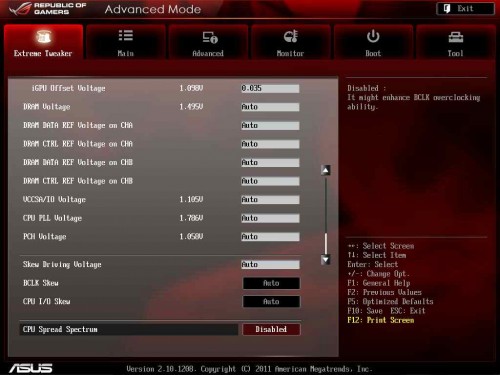My Asus Maximus IV GENE-Z has been giving me headaches. And I’m not just talking about the pain it was to hackintosh.
No, it’s been acting all fruity. And it’s done this periodically since I first got it actually. Any time I start messing with clocks and/or voltages, if things go bad and I go-back-to-start and reset the BIOS, things don’t work even at stock settings (OCCT fails, Prime95 fails, etc).
Until they do. Magically. Mess around with every setting, find some that aren’t ideal but happen to work. And then I don’t touch anything for a long while for fear the motherboard might have another tantrum.
—
While undervolting the CPU, it started doing it again.
It worked at 1.20V.
It worked at 1.18V.
It worked at 1.14V.
It didn’t work at 1.10V (I got greedy).
Then it didn’t work at 1.14. Or 1.18. Or 1.20. Or at “Auto”. Or after a BIOS reset. What the heck? These settings all worked fine 30 minutes ago! Now the board would boot into Windows, but as soon as I ran OCCT or Prime95 it would fail within 5 seconds. And then if I ran OCCT/Prime again immediately, it would sometimes work.
Killing the power, resetting the BIOS, and glaring angrily at the motherboard had no effect.
Frustrating.
Anyway, before this turns into a sob story, it looks like I’ve come across a fix of sorts.
Above, you can see I had previously left most stuff at “Auto” (except the iGPU I was playing with at the time).
If you’re particularly astute, you might notice that VCCIO and VCCSA are combined into one voltage setting. If you’ve delved into info on these though, you’ve probably found that:
- Stock for VCCSA is supposed to be 0.925v (min 0.879, max 0.971).
- Stock for VCCIO something in the neighborhood of 1.05V (+/- 3%).
Now since these are different values, it probably seems odd that they’re combined. And it is. Somebody called ASUS out on it, and the response was “the rails are tied…this is the way it is done on all Z68 chipset boards…. VCCIO and VCCSA become tied to the same buck controller“.
Anyway, the auto voltage on my board for this was a bit higher than what either are really supposed to be. I’d tried bumping the voltage up slightly previously (my RAM was having issues and VCCIO is supposed to help with that, particularly with 4 banks full), but I had never thought to try bumping it down.
Since I was going to bump that down, I figured I’d look around on the web to check my options and undervolt a few other things at the same time.
After all, when faced with the prospect that changing something may-or-may-not work, change everything.
I ended up bumping down a few things:
- VCCSA/IO went down to 1.0v
- CPU PLL took a mighty drop to 1.5v
- PCH voltage took a tiny drop to ~1.02v (didn’t want to go crazy here – it shouldn’t matter for stability, and going too far might mean data corruption. I did this one just-because-I-felt-like-it).
While in the process of under-volting these, I also thought I may as well try undervolting my RAM. I figured this would be a fool’s errand since my 4x4GB Corsair CMZ8GX3M2A1600C9B memory had barely been making it at it’s rated DDR1600 @ stock timings at the stock 1.5v so far as I could tell. I wondered if it would even POST at 1.49.
I tried 1.45v on the RAM, which shocked me by both POSTing, and passing Memtest.
Then I tried 1.40v, figuring “this will never even POST“. To my surprise, it did. And to my much larger surprise, it passed in Memtest too.
—
So suddenly, by dropping the voltage on other stuff, I had stability. Stability that I hadn’t seen on this board until now. Less-than-default-voltage means that Prime95 is running flawlessly in the other room right now.
At this point, I’m pretty sure that all the issues I’ve run into on this Maximus IV GENE-Z were due to the voltage on something being too high. If I had to guess, I’d assume it was the VCCSA/IO. I suppose I could test further, but this MB has managed to put me in the mindset that if something’s working, I probably shouldn’t try to break it again.
—
In retrospect, higher voltages does make sense for a board of this nature – it’s designed for overclocking. That’s probably why the moment I turn something (like the iGPU frequency) up, it cranks up the idle vCore to about 1.5v (at least until I notice, freak out, and manually turn it down).
I think I made a false assumption long ago. An assumption that an enthusiast board would work swimmingly when I have most things at/near stock, and simply give me headroom when it comes to under/overclocking. As it turns out, the board assumed I was a hard core overclocker, and when I wasn’t, we didn’t quite get along.
In any case, if you’re using this board and running into issues underclocking, undervolting, and/or near stock, try dropping a few of the voltages a little bit.
You might be surprised.
